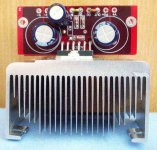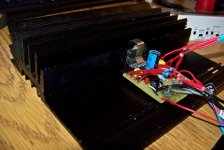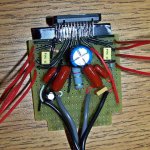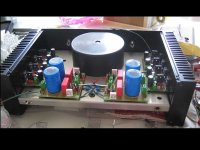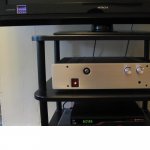My God!.. certainly built on a 'trouser flapper' scale.
Do you know what hz they go down to? Is it a sort of horn TL system?
Do you know what hz they go down to? Is it a sort of horn TL system?
They are a back loaded horn design. If you look at the Fostex website you will see the design for the 208 cabinet. The speaker sits in front of what is called the throat which creates pressure behind the driver, this then flows down through the folded horn, and out throuhg the mouth at the front.
It is said that the design optimises the pressure on the speaker cone and it is effectively driving the room. Bass is probably 40Hz
(but will be room dependant)
They say you either love or hate horns. I love mine.
It is said that the design optimises the pressure on the speaker cone and it is effectively driving the room. Bass is probably 40Hz
(but will be room dependant)
They say you either love or hate horns. I love mine.
ahh, good old fostex.. i had some Foster tweeters from the 70s that were quite impressive.
i also had some 4" drivers somewhat like the ones your using. never really did anyting with them tho, a friend had given me a ton of the 3" tweeters, 5 1/4" midranges and those weird 4" dual cone drivers.
the tweeters and midranges i used a bunch of and loved
foster changed their name to fostex at one point, dont know why tho?
i also had some 4" drivers somewhat like the ones your using. never really did anyting with them tho, a friend had given me a ton of the 3" tweeters, 5 1/4" midranges and those weird 4" dual cone drivers.
the tweeters and midranges i used a bunch of and loved
foster changed their name to fostex at one point, dont know why tho?
Redshift187 said:My first (successful) chip amp, a TDA7560 car amp, in a Zapco AG150 for enclosure: [/QUOTE ]
I dont think you will have any overheating issues with that heatsink!
Nice!
cheers/H@kan
Thanks. Yeah, playing fairly loud with two 4 ohm speakers while testing, the heatsink never even got warm.
you use active x-over filters?
if so, you have like my dream system
because active 3-way systems have so many benefits
before one amplifier driving a passive components x-over + 3 drivers
one such benefit is increased speaker sensitivity, efficiency
some crossovers can 'steal' -3 dB
which means power amplifier must put out twice as much Watt
and distortion increases with Watt output
In addition 3 amplifiers per channel, will share the job
and so further reduce the power Out needed per each amp
As each ampifier take only one portion of the frequency spectrum
each amplifier can be trimmed customly to work optimally only at those frequencies
The quality of active op-amp x-over with low value capacitors, compared to large value passive inductors and capacitors
is so much better, it is almost beyond comparable level.
Good thinking, Tranceformer 😎
And most probably one real Hi-fi amplifier
Lineup internet audio group
.
if so, you have like my dream system
because active 3-way systems have so many benefits
before one amplifier driving a passive components x-over + 3 drivers
one such benefit is increased speaker sensitivity, efficiency
some crossovers can 'steal' -3 dB
which means power amplifier must put out twice as much Watt
and distortion increases with Watt output
In addition 3 amplifiers per channel, will share the job
and so further reduce the power Out needed per each amp
As each ampifier take only one portion of the frequency spectrum
each amplifier can be trimmed customly to work optimally only at those frequencies
The quality of active op-amp x-over with low value capacitors, compared to large value passive inductors and capacitors
is so much better, it is almost beyond comparable level.
Good thinking, Tranceformer 😎
And most probably one real Hi-fi amplifier
Lineup internet audio group
.
beautiful amp transformer. i love the sinks!
this is a pic of my amp since its finally 99% finished. finished building the crossover and tested it lastnite, at first it worked horrible, i couldnt figure out why but the level dropped off at 500Hz or so on the woofer. finally discovered i installed 10nf caps where i had ment to put 10UF caps. and instead planned on jumpering it. after jumpering the pads i had a flat response to 20Hz with a slight dropoff below it
tweeter is crossed at 1500Hz as per orignal spec. these will be bolted into the 1977 powered advents in restoring.
this is a pic of my amp since its finally 99% finished. finished building the crossover and tested it lastnite, at first it worked horrible, i couldnt figure out why but the level dropped off at 500Hz or so on the woofer. finally discovered i installed 10nf caps where i had ment to put 10UF caps. and instead planned on jumpering it. after jumpering the pads i had a flat response to 20Hz with a slight dropoff below it
tweeter is crossed at 1500Hz as per orignal spec. these will be bolted into the 1977 powered advents in restoring.
Attachments
Thanks Lineup I think you have the same philosophy. First I was thinking about building a tube amp. But then I said to myself that the weekest part in the whole chain will be the loudspeaker. So what can you do to improve the performance of a loudspeaker?
I decided to go active with a 3 way "Gainclone" based amplifier. In the lower part of the case I am using the DSP Board from the DCX2496. That means I can control the crossover via RS232 from my notebook. The main reason to use a digital crossover: you can align the phase between high, mid and bass speakers and it is easy to make corrections depending on the room. It makes sense to use a digital input and to stay in the digital domain when you are using a digital crossover. In my system I have from the spdif input to the loudspeaker only one capacitor. I have spent allot of time to reduce the noise as far as possible. So I finaly changed my PCB design and used switch mode Power Supplys.
Here is a picture of the new design:
I decided to go active with a 3 way "Gainclone" based amplifier. In the lower part of the case I am using the DSP Board from the DCX2496. That means I can control the crossover via RS232 from my notebook. The main reason to use a digital crossover: you can align the phase between high, mid and bass speakers and it is easy to make corrections depending on the room. It makes sense to use a digital input and to stay in the digital domain when you are using a digital crossover. In my system I have from the spdif input to the loudspeaker only one capacitor. I have spent allot of time to reduce the noise as far as possible. So I finaly changed my PCB design and used switch mode Power Supplys.
Here is a picture of the new design:
Attachments
this is a pic of my amp since its finally 99% finished.
Hi thetube0a3 I was thinking to build some active speekers for a studio and your picture shows exactly what I need 🙂. Are you using a Kit or is the board your own design?
Hi thetube0a3 I was thinking to build some active speekers for a studio and your picture shows exactly what I need 🙂. Are you using a Kit or is the board your own design?
own design. took me 4 months and alot of $$ to get where i am, but its been fun 🙂
its also been a learning experience..
its also been a learning experience..
thetube0a3 said:own design. took me 4 months and alot of $$ to get where i am, but its been fun 🙂
its also been a learning experience..
Wow, great job. I can imagine it took a while.
A very good design and a good mechanical solution. I seems you are also using parallel chips to get more power. Did you use a special design for the crossover?
bridge-parrelle for the woofer amp actaully.
the crossover has 2 diff boards the one in the picture is a 12db\octave linkwitz riley. i also have a 24db/octave linkwitz riley.
the 12db one is for the advents, while i made the 24db ones for other speakers.
the boards can also be used without the crossover.
the crossover has 2 diff boards the one in the picture is a 12db\octave linkwitz riley. i also have a 24db/octave linkwitz riley.
the 12db one is for the advents, while i made the 24db ones for other speakers.
the boards can also be used without the crossover.
12 dB Linkwitz-Riley are filters I like.
And is also probably the most used x-over in the world.
Not without good reasons 😎
And is also probably the most used x-over in the world.
Not without good reasons 😎
Noxon
Hello there! Well I just got a good product to clean and polish those wonderful aluminum chassis,the name is "NOXON" 7 metal polish.stainless steel,aluminum,chrome,pewter,brass,bronze and copper.it costs around $7 12fl.oz (354ml).I have used it in my integrated amp and it looks great now.take a look!.
Hello there! Well I just got a good product to clean and polish those wonderful aluminum chassis,the name is "NOXON" 7 metal polish.stainless steel,aluminum,chrome,pewter,brass,bronze and copper.it costs around $7 12fl.oz (354ml).I have used it in my integrated amp and it looks great now.take a look!.

Attachments
- Home
- Amplifiers
- Chip Amps
- Chip Amp Photo Gallery
